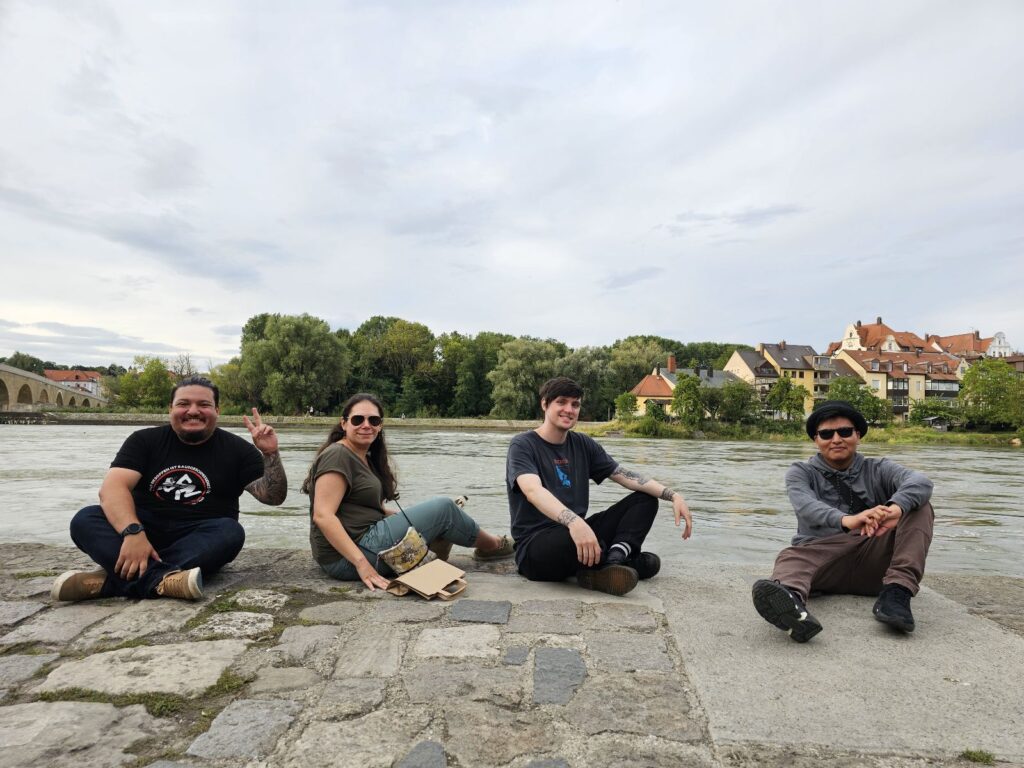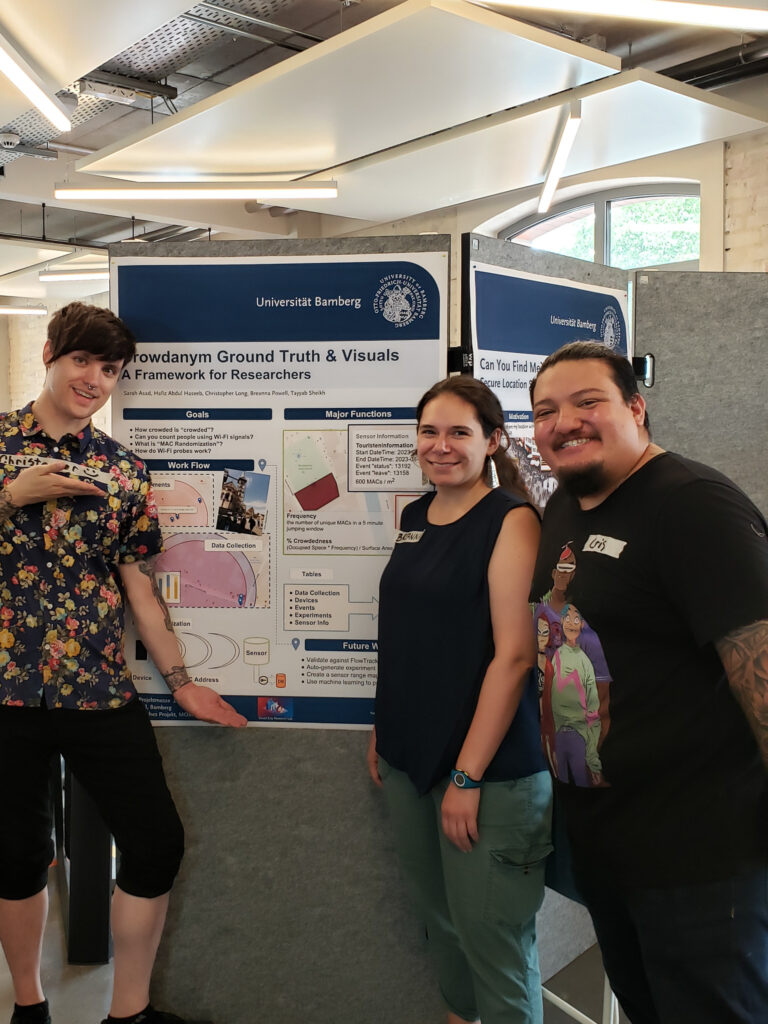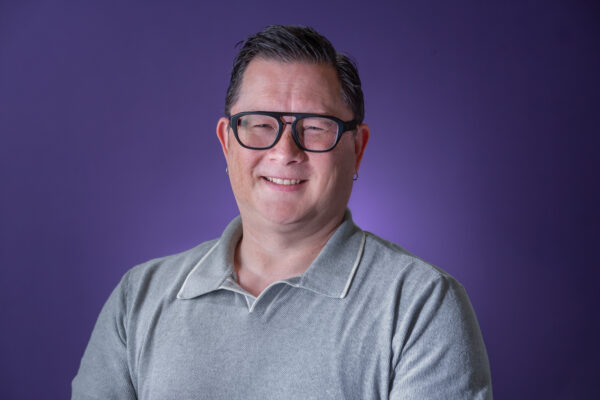For many cities, tourism can be both a boon and a curse. The same crowds that bring in money to businesses and communities, for example, can pose a risk not only to the functionality of a city but also to its safety.
To begin to understand this dynamic, students from the University of Washington Bothell went to in Bamberg, Germany, in summer 2023 worked to provide a tech-driven solution for crowd management, with a focus on both security and privacy concerns.
Over the course of 10 weeks, a group of five students overseen by Dr. Brent Lagesse, associate professor in the School of STEM, kicked off a three-year research project to collect data and examine the complex interactions of people and services in a city as part of a “smart cities” initiative in Germany.
“There’s a lot of information that can be derived from knowing where people are and where people are headed,” Lagesse said. “Cities can use these technologies to better understand where flows of people are at certain times of the year so they can deploy resources in the places where they are most needed — and do so without relying on private industry that might be using their data to sell advertisements.”
International collaboration
Lagesse began planning the smart cities project in collaboration with fellow researchers while teaching as a guest professor in Germany during a sabbatical in 2019. The team had previously worked on smart city research together in 2017. Excited by how the project could be used as a test bed for security, privacy, machine learning and other concepts, he wanted to find a way to engage his students at UW Bothell in the project.
After proposing a summer abroad experience, he received funding through a National Science Foundation program. Although he planned to send the first cohort of students to Germany in 2020, the project was postponed due to the COVID-19 pandemic.
While Lagesse and his first cohort of students weren’t able to join until 2023, the University of Bamberg’s Smart City Research Lab got the project underway in the meantime. And because their German counterparts were continuing to work throughout the academic year before their summer arrival, UW Bothell students didn’t know at what point they would be entering the process.
“Since it was the first year for us to do this, we were adapting and learning a lot on the fly,” Lagesse said. “Our plans from three years ago didn’t immediately translate into where the research was by the time we got there.”
They finally arrived in Bamberg in June 2023 and had to quickly get their bearings — both within a new culture and within the ongoing research project.
“For me, the highlight was the opportunity to travel to another country,” said Anthony Bustamante Suarez, a master’s student in Cybersecurity Engineering. “Germany is so beautiful and traveling around by train was so cheap and easy. Having the possibility to go to different places and appreciate the culture was amazing.”

Anonymity challenges
One of the first things the students did for the research project was gather baseline data that could help establish what crowded conditions were for the city. Together with their counterparts from the University of Bamberg, the students worked in four teams — each focused on a different aspect of the project.
As a member of the project’s Data Poisoning team, Bustamante Suarez worked on the security of the system and used machine learning techniques to look for anomalies in the data and test the vulnerability of the system. Sarah Asad worked on both the Data Poisoning and the Ground Truth and Visualization teams.
“Before we go into creating big applications using these sensors, we want to secure everything within it,” said Asad, a fourth-year CSSE major. “We had to find out how to secure the data and make sure we’re not prone to any attacks.”
Using Wi-Fi sensors, students were able to detect MAC addresses, or the unique identifier for the interface that devices use to interact with networks. One of the greatest challenges throughout the project, the students said, was MAC randomization, which provides anonymity to devices by scrambling their MAC addresses.
“A classic security problem is, how do you learn a lot of stuff about people at the same time without learning too much about them or identifying their individual preferences or behaviors?” Lagesse said. “That’s always a challenge, and this is what makes the research interesting.”
Signs posted around the sensors notifying passersby of the project also provided instructions for how to opt out of the experiment, adding another opportunity for missed or misinterpreted data.
Qualifying the data
As part of the Ground Truth and Visualization team, Christopher Long and Breanna Powell developed a framework for researchers to better understand the data quality from the sensors and to perform experiments.
“Our team’s goal was to make sure that what was happening in the system matched what was happening in real life,” said Long, a fourth-year Computer Science & Software Engineering major. “We were attempting to visualize that and to find correlations between real life and the model. We ran tests throughout our time there to try and bridge the gap between the two and get a better idea of what was going on.”
The team also put together maps to visualize where the sensors were picking up people and devices. On site, the students manually counted people to compare with the data the sensors collected. They ran experiments to see if signal strength was a good indicator for where and how far away people were standing and moving through an area. Additionally, they looked into whether the moving signals were capturing the direction people traveled in while filtering out passing cars, bikes and stable devices.
“Being able to accurately count how many people are there and figure out the level of crowdedness is vital for the city to create new services that will help reroute tourists throughout the city. I think what we were able to set up will help with that goal in the future,” said Powell, a master’s student in the CSSE program.
Handing off the baton

In the final week of this summer research experience, the group presented its findings to other people who work on smart city projects in Bamberg, allowing the students to see how their work fit in with broader smart city planning. One similar project used real-time cameras and computer vision to monitor the streets, and the students were able to compare the strengths and weaknesses of the two different tracking systems.
This fall quarter, back at UW Bothell, the students will pull together what they’ve learned from the experience to help inform the cohort for next year’s stage of the research.
“We created a structure for how experiments could be conducted in the future so next year’s teams can pick up where we left off,” said Powell. “I think that was a really big contribution that we’ve made to the future of this project, just setting up the framework for what they can do in the years to come.”
Students interested in learning more or participating in future cohorts can visit the project website.



